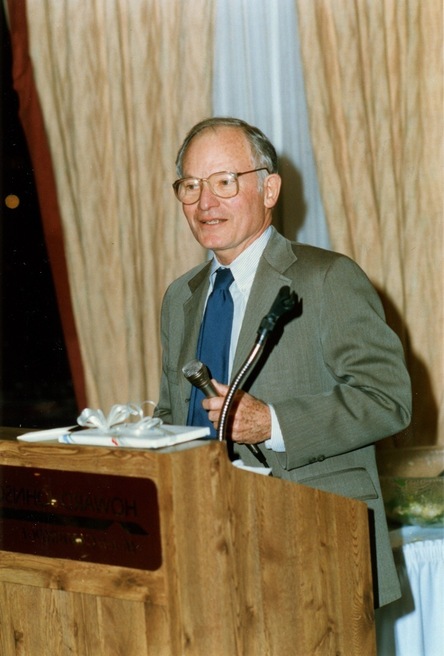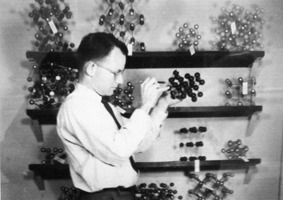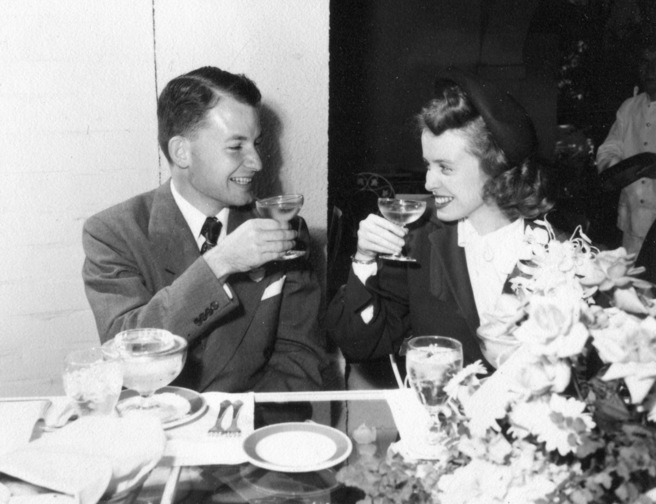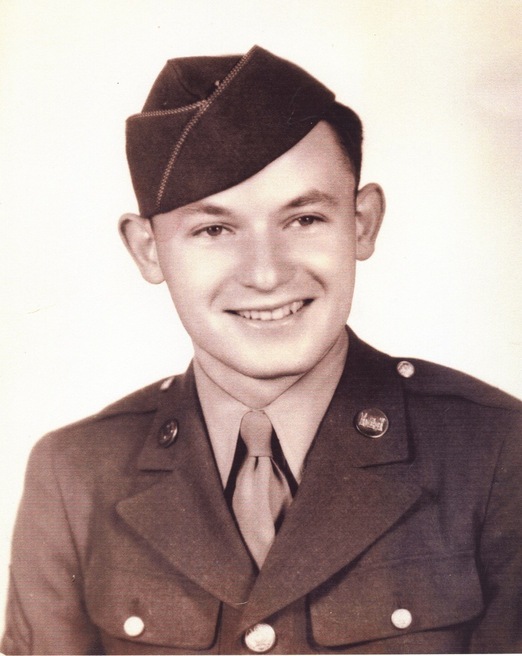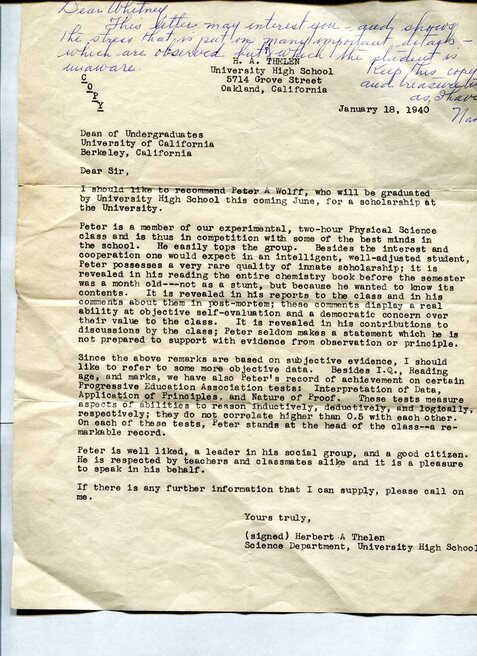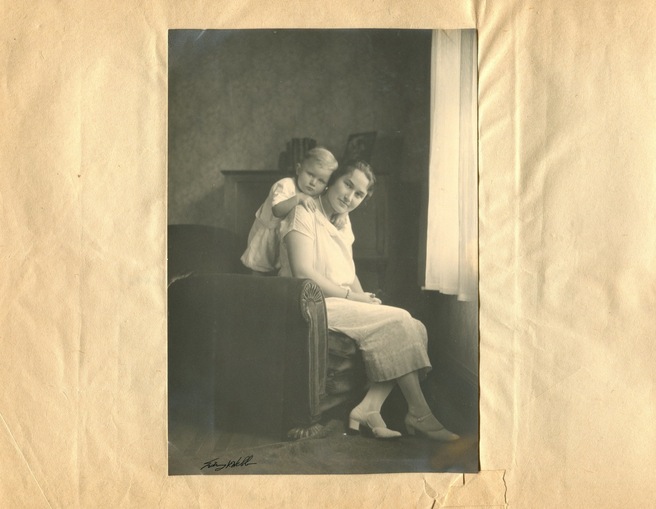Peter A. Wolff
Born: November 15, 1923 Oakland, California
Citizenship: U.S.
Degrees:
A. B. Physics -- University of California, Berkeley (1945)
Ph. D. Physics -- University of California, Berkely (1951)
Employment History:
Research Scientist, Lawrrence Radiation Lab 1951-52
Staff Scientist, Bell Telephone Labs 1952-63
Professor of Physics, University of California,
(San Diego) 1963-64
Department Head and Director of Electronics
Research Laboratory, Bell Telephone Labs 1964-70
Major Research Interests:
Light scattering, solid state plasmas, semiconductors, nonlinear optics
Books
P. M. Platzman and Peter A. Wolff, Waves and Interactions in Solid State Plasmas. (Academic Press), New York and London, 1973).
Papers
1. "Excitation Function of the Reaction C12 (p,pn) C11 at High Energies", (with W. Heckrotte), Phys. Rev. 73, 264 (1948)
2. "Production of mu-mesons by Gamma Rays", Phys. Rev. 81, 1055 (1951).
3. "Radiation from an Electron in a Magnetic Field", (with D. L. Judd, J. V. Lepore and M. Ruderman), Phys. Rev. 86, 123 (1952).
4. "The Scattering of Protons from Carbon", Phys. Rev. 87, (1952).
5. "Theory of Plasma Waves in Metals", Phys. Rev. 92, 18 (1953).
6. "Theory of Secondary Electron Cascade in Metals", Phys. Rev. 95, 56 (1954).
7. "Theory of Electron Multiplication in Silicon and Germanium", Phys. Rev. 95, 56 (1954).
8. "Theory of Plasma Resonance", Phys. Rev. 103, 845 (1956).
9. "Theory of Plasma Resonance in Solids", Phys. Rev. 112, 66 (1958).
10. "Effects of Electron Correlation on the Optical Properties of Metals", Phys. Rev. 116, 544 (1959).
11. "Effect of Landau Levels upon Tunnel Currents in Indium Antimonide", (with A. G. Chynoweth and R. A. logan), Phys. Rev. Lett. 5, 548 (1960).
12. "Spin Susceptibility of an Electron Gas", Phys. Rev. 120, 814 (1960).
13. "Theory of Optical Radiation from Breakdown Avalanches in Germanium", J. Phys. Chem. Solids 16, 184 (1960).
14. "Ferromagnetism in Dilute Solutions of Cobalt in Palladium", (with R. M. Bozorth, D. D. Davis, V. B. Compton and J. H. Wernick), Phys. Rev. 122, 1157 (1961).
15. "Localized Moments in Metals", Phys. Rev. 124, 1030 (1961).
16. "Pair Correlation in a Plasma", Phys. Fluids 5, 316 (1962).
17. "Magnetization of Localized States in Metals", (with P. W. Anderson, A. M. Clogston, B. T. Matthias, M. Peter and H. J. Williams), J. Appl. Phys. Supplement 33, 1173 (1962).
18. "Theory of the Band Structure of Very Degenerate Semiconductors", Phys. Rev. 126, 405 (1962).
19. "Effect of Correlation on the High-Frequncy Conductivity of an Electron Gas", Phys. Rev. 132, 2017 (1963).
20. "Nuclear relaxation as a Probe of Electron Spin Correlation", Phys. Rev. 129, 84 (1963).
21. "Quantum Effects in the Infrared Reflectivity of Bismuth", (with L. C. Hebel), Phys. Rev. Lett. 11, 368 (1963).
22. "Matrix Elements and Selection Rules for the Two-Band Model of Bismuth", J. Phys. Chem. Solids 25, 1057 (1964).
23. "Proposal for a Cyclotron Resonance Maser in InSb", Physics 1, 147 (1964).
24. "Effect of Open Orbits on Helicon and Alfven-wave Propagation in Solid-State Plasmas", (with S. J. Buchsbaum), Phys. Rev. Lett. 15, 406 (1965).
25. "Thomson and Raman Scattering by Mobile Electrons in Crystals", Phys. Rev. Lett. 16, 225 (1966).
26. "Giant Density Fluctuations in Semiconductors", J. Phys. Chem. Solids 27, 685 (1966).
27. "Relation Between the Anderson and Kondo Hamiltonians", (with J. R. Schrieffer), Phys. Rev. 149, 491 (1966).
28. "Theory of a Tunable Raman Laser", IEEE J. Quantum Electronics QE-2, 659 (1966).
29. "Theory of Optical Mixing by Mobile Carriers in Semiconductors", Phys. Rev. Lett. 17, 1015 (1966).
30. "Spin-Wave Excitation in Nonferromagnetic Metals", (with P. M. Platzman), Phys. Rev. Lett. 18, 280 (1967).
31. "Effect of Nonparabolicity on Light Scattering from Plasmas in Solids", Phys. Rev. 171, 436 (1968).
32. "Light Scattering from a Plasma in a Magnetic Field", (with P. M. Platzman and N. Tzoar), Phys. Rev. 174, 489 (1968).
33. "Light Scattering from Mobile Electrons in Semiconductors" in Proceedings of the IX International Conference on the Physics of Semiconductors, Moscow, July 23-29, 1968 (Nauka, Leningrad, 1968).
34. "Light Scattering from Solid State Plasmas" in Light Scattering Spectra of Solids, Proceedings of the International Conference on Light Scattering Spectra of Solids, New York, September 3-6, 1968 (Springer-Verlag, New York, 1968).
35. "Theory of Light Scattering from Magnetoacoustic Waves in Solid-State Plasmas", Phys. Rev. B1, 164 (1970).
36. "Theory of Light Scattering from Coupled Electromagnetic-Magnetoplasma Modes in Semiconductors", Phys. Rev. B1, 950 (1970).
37. "Plasma Wave Instability in Narrow-Gap Semiconductors", Phys. Rev. Letts. 24, 266 (1970).
38. "Stimulated Emission of Plasmons in Narrow-Gap Semiconductors", in The Physics of Semimetals and Narrow Gap Semiconductors, edited by Carter and Bate (Pergamon Press, Oxford and New York, 1971).
39. "Theory of Stimulated Light Scattering from Electrons in Semiconductors", in Proceedings of the Second International Conference on Light Scattering in Solids, Paris, July 19-23, 1971 (Flammarion Sciences, Paris, 1971).
40. "Electronic Structure of Semiconductors" in Electronic Materials, edited by N. Bruce Hannay and Umberto Columbo (Plenum Publishing Corp., New York, 1972).
41. "Nonlinear optics" in Electronic Materials, edited N. Bruce Hannay and Umberto Colombo (Plenum Publishing Corp,. New York, 1972).
42. "Theory of Resonant Far Infrared Generation In InSb", (with T. L. brown), Phys. Rev. Lett. 29, 362 (1972).
43. "Electron Scattering as a Probe of Nuclear Wave Functions in Solids", (with Vikas Sukhatme), J. Appl. Phys. 44, 2331 (1971).
44. "Stimulated Compton Scattering as a Radiation Source -- Theoretical Limitations", (with Vikas Sukhatme), J. Appl. Phys. 44, 2331 (1973).
45. "Spin Nonlinearities in In Sb" in Proceedings of the International Conference on Narrow Gap Semiconductors, Nice, 1973
46. "Output Behavior of Electronic Spin-Flip Raman Lasers", (with S. Y. Yuen and B. Lax), Optics Comm. 10, 4 (1974).
47. "Theory of Spin-Flip Raman Scattering Line Shape in Narrow-Gap Semiconductors", (with S. Y. Yuen and B. Lax), Phys. Rev. 89, 3394 (1974).
48. "Raman Scattering from Coherent Spin States in n-Type Cds", (with R. Romestain, S. Geschwind and G. E. Devlin), Phys Rev. Letts. 33, 10 (1974).
49. "Theory of Traveling-Wave Electronic Raman Lasers -- Stokes-Anti-Stokes Coupling in the Steady State", (with S. Y. Yuen and B. Lax), Phys Rev. A10, 416 (1974).
50. "Stress-Tuned Stimulated Light Scattering in p-Type Semiconductors", (with S. Y. Yuen and B. Lax), Sol. State Comm. 14, 1079 (1974).
51. "Stimulated Magneto-Compton Scattering - A Possible Tunable Far Infared and Millimeter Wave Source" (with Vikes Sukhatme), J. Quantum Elec. QE-10, 870 (1974).
52. "Chemical Bond Approach to the Magnetic Susceptibility of Tetrahedral Semiconductors", (with Vikas Sukhatme), Phys Rev. Letts. 35, 1369 (1975).
53. "Free Electron Nonlinear Optical Processes in Semiconductors" in Proceedings of the Scottish univeristy Summer School in Physics, 1975.
54. "Spin Dynamics and Four Photon Mixing in InSb" (with V. T. Nguyen and E. G. Burkhardt), Optics Comm. 16, 145-148 (1976).
55. "Coherent Effects in Spin-Flip Light Scattering", (with R. N. Nucho and R. L. ggarwal), IEEE, Journal of Quantum Elec. QE-12, 500 (1976).
56. "Spin-Flip Nonlinearities in Semiconductors" in Laser Photochemistry, Tunable Lasers and Other Topics (Physics of Quantum Electronics, Vol. IV) edited by S. F. Jacobs, M. Saregent, M. O. Scully and C. T. Walker, (Addison-Wesley, Reading, Mass., 1976).
57. "Theory of Spin-Flip Line Shape in Cds", (with J. G. Ramos and S. Y. Yuen) in Theory of Light Scattering in Condensed Matter, edited by B. Bendw, J. L. Birman and V. M. Agranovich (Plenum Publishing Corp., New York, 1976).
58. "Dispersion of the Nonlinear Optics Susceptibility of n-Type Germanium", (with R. A. Wood, M. A. Khan, and R. L. Aggarwal), Optics Comm. 21, 154-57, (1977).
59. "A Chemical Bond Approach to the Electric Susceptibility of Semiconductors, I", (with R. N. Nucho and J. G. Ramos), Phys. Rev. B 17, 1843 (1978).
60. "A Chemical Bond Approach to the Electric Susceptibility of Semiconductors, II", (with R. N. Nucho and J. G. Ramos), Phys. Rev. B17, 1843 (1978).
61. "Resonant Four Wave Mixing in n-Type Silicon", (with M. A. Khan and D. J. Muehlner) (1979).
62. "Surface Enhancd Raman Scattering", (with S. L. McCall, P. M. Platzman), Phys. Lett. A77, 381 (1980).
63. "Effect of Magnetic Field on the Valley-Orbit Split 1s States of Shallow Donors in Germanium" (with R. L. Aggarwal, R. People and D. M. Larsen), J. Phys. Soc. Jpn. 49, 197 (1980).
64. "Collective Modes of Photoexcited Electron-Hole Plasmas in GaAs", (with A. Pinczuk and J. Shah), Phys. Rev. Lett. 47, 1487 (1981).
65. "Nonlinear Absorption Due to Shallow Donors in Gemanium at 1.6 m" (with J. McManus, R. People and R. L. Aggarwal), J. Appl. Phys. 52, 4748 (1981).
66. "Off-diagonal Zeeman Effects in the Ground State Manifold of n-Ge" (with R. People), Phys. Rev. B 24, 4634 (1981).
67. "Diamagnetic and Zeeman Shifts of the Ground State of Arsenic Donors in Germanium" (with C. Jagannath, E. R. Youngdale, D. M Larsen and R. L. Aggarwal), Solid State Comm. 43, 267 (1982).
68. "Difference-Frequcny Variation of the Free-carrier-Induced Third Order Nonlinear Susceptibility in n-InSb" (with S. Y.Yuen), Appl. Phys. Lett. 40, 457 (1982).
69. "Electrc-Dipole Spin Resonance of Bound Electronic States in Cd1-xMnxSe" (with M. Dobrowolska, H. D. Drew, J. K. Furdnya, T. Ichiguchi and A. Witowski), Phys. Rev. Lett. 49, 845 (1982).
70. "Plasmon-Assisted Recombination in Narrow-Gap Semiconductors in a Magnetic Field" (with C. Verie and S. Y. Yuen), J. Vac. Sci. & Technol. 21, 231 (1982).
71. "Bound Magnetic Polarons and Spin Flip Raman Scattering in (Cd,Mn)Se" (with D. Heiman and J. Warnock), Physica 117B & 118B, 485 (1983).
72. "Nonlinear Optical Studies of Picosecond Relaxation Times of Electrons in n-GaAs and n-GaSb", (with K. Kash and W. A. Bonner), Appl. Phys. Lett. 42, 173 (1983).
73. "Spin-Flip Scattering, Bound Magnetic Polaron and Fluctuations in (Cd,Mn)Se" (with D. Heiman and J. Warnock), Phys Rev. B 27, 4848 (1983).
74. "Bound Magnetic Polarons in Dilute Magnetic Semiconductors" (with J. Warncok), J. Appl. Phys. 55, 2300 (1983).
75. "Far-InFrared Observation of the Electric-Dipole Spin Resonance of Donor Electrons in Cd1-xMnxSe", (with M . Dobrowolska, A. Witowski, J. K. Furdyna, T. Ichiguchi and H. D. Drew), Phys. Rev. B 29, 6652 (1984).
76. "High Magnetic Fields for Physics", (with L. G. Rubin), Phys. Today, 37, 24 (1984).
77. "Polarized Photoluminescence from Bound Magnetic polarons in (Cd,Mn)Se", (with D. Heiman, J. Warnock, R. Kershaw, D. Ridgely, K. Dwight and A. wold), Solid State Comm. 52, 909 (1984).


